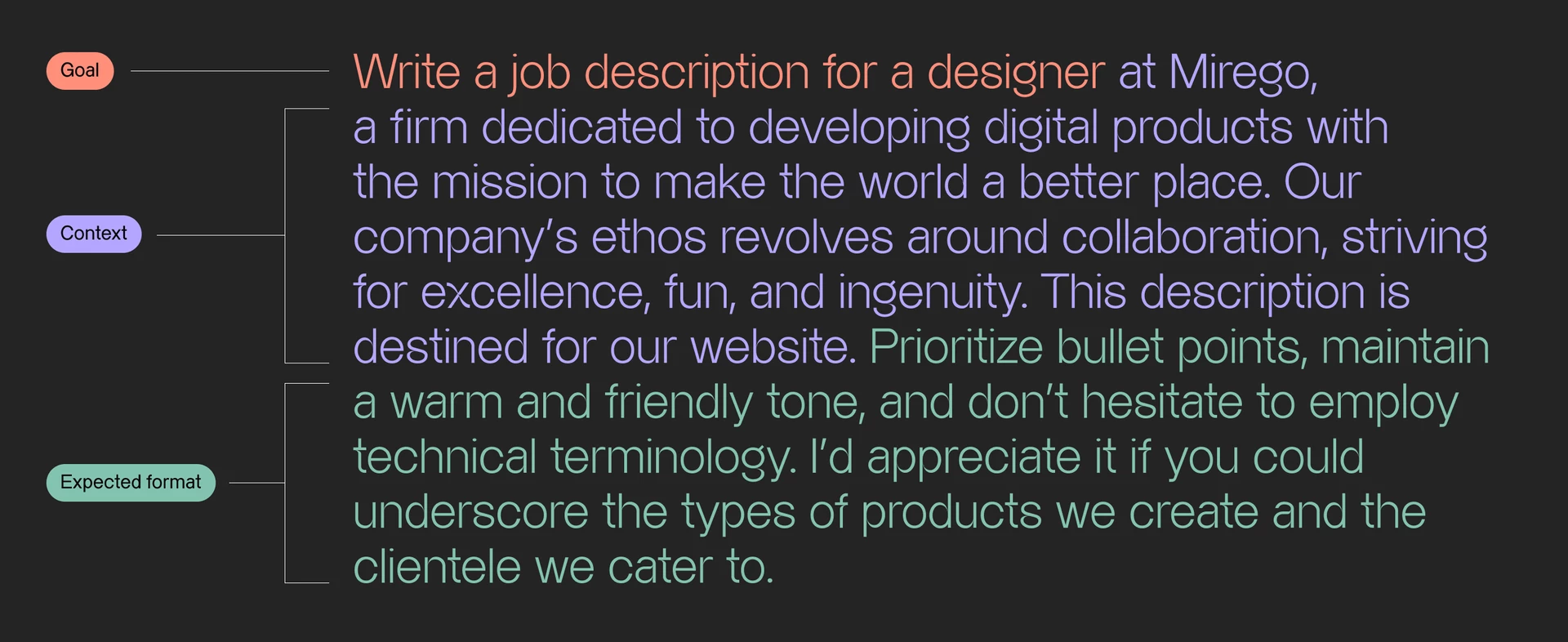- AI
- Strategy
Three levels of AI to improve your efficiency and maximize its impact
April 8 — 2024


Artificial intelligence is revolutionizing the business landscape at an unparalleled pace and scale. Barely a year since ChatGPT's introduction, OpenAI has reported achieving 100 million weekly users, 2 million developers, and adoption by 92% of Fortune 500 companies for its LLM-type models. Consequently, it's hardly surprising that 72% of executives view these technologies as the key business leverage for the future.
Understanding Artificial Intelligence (AI) is not just an advantage, it's essential.
Considering the digital product industry's ever-evolving landscape, AI's role in our products and workflows is growing more pivotal. Through various projects, we've observed significant variances in the required levels of complexity and expertise. To address this, Mirego has crafted a framework that enables us to classify AI projects by three maturity levels.
Artificial intelligence is to digital products what food planning is to event organization: a crucial component that can manifest in diverse ways, demanding varied approaches, investments, and levels of complexity.
Level 1: Leveraging existing platforms
On the initial level, the focus is on leveraging existing AI tools that don't demand advanced technical expertise. Drawing on the dinner party analogy, this is akin to dining out at a restaurant. Here, the pivotal decision is selecting the location, since the menu, atmosphere, and overall experience are in the restaurateur's hands. For a level 1 project, the task is essentially to pick the appropriate tool (e.g., Gemini, ChatGPT, Copilot).
Tools such as ChatGPT and DALL-E are paving the way for unprecedented creative possibilities, enabling anyone to produce text and images through straightforward prompts. Many executives, upon their initial encounter with these tools, ponder over how AI could streamline their team's workflows. Frequently, the realization dawns that it's already too late — their teams have embraced these technologies. It's essential, therefore, to consider the potential risks, particularly regarding the safeguarding and handling of sensitive data within one's organization.
In such projects, mastering the art of prompt engineering suffices. For many of us, a query essentially represents an objective. For instance:

However, a good query should, in addition to the objective, include various elements such as the context (the reason behind the task, important details, and crucial information) and the expected format (tone, length, format, etc.).
Below is how you can refine the same prompt to yield a more thorough, suitable, and accurate answer from the model.

For those seeking a challenge, creating custom assistants is now possible. These are advanced iterations of GPT (Generative Pre-trained Transformer) language models designed to tailor the model's interactions to the user's unique preferences. Unlike their generic counterparts, which are broad-spectrum tools equipped to handle diverse inquiries with no particular customization, solutions like MyGPT now empower users to mold the model to fit their distinct desires, interests, or requirements. Remarkably, even those without technical expertise can engineer a bespoke GPT, guiding its actions through a personalized knowledge base (user-provided documentation uploaded to the platform) and specific directives.
Mirego has leveraged these technologies to develop Inclusivo, a virtual assistant designed to enhance the inclusivity of French textual content.

Level 2: Integrating existing tools into tailored solutions
The second level focuses on the integration of AI into custom solutions that meet the specific needs of organizations. Continuing with the dinner party analogy, this stage parallels hosting an event at your place, where you oversee the full spectrum of the guest experience, yet you bring in a professional caterer who far surpasses your culinary skills.

La Ruche's redesigned website, a crowdfunding platform, exemplifies how AI can be integrated into a digital product. Mirego has introduced an AI-powered functionality that automatically enhances the descriptions of community-submitted crowdfunding projects. This approach to AI integration doesn't rely on users creating accounts with Gemini, ChatGPT, or similar services. Instead, it utilizes a GPT model to power a feature designed to elevate the user experience on the platform.
These initiatives, which skillfully combine AI tools and software development, embody our vision of the future through AI: an omnipresent technology that discreetly but significantly improves our daily lives.
In the years ahead, we'll see an abundance of Level 2 products and experiences that, unbeknownst to us, will feel magical due to ingeniously and elegantly integrated models. From a travel application featuring model-generated advice, a search bar demystifying technical documentation with the help of synthetic intelligence, to highly personalized product recommendations aligned with user profiles; the possibilities are nearly boundless.
Mirego's strategy for these kinds of projects is straightforward: if a model exists that can create a standout experience, it's preferable to leverage it. However, it is possible that a task is so specific that the broad models available are not sufficiently performant. Such instances fall under level 3.
Level 3: Building custom AI models
At the top of this maturity framework lie projects requiring the creation of customized AI models. Drawing on the dinner party analogy, this is akin to bringing in a personal chef to craft an exclusive, custom-designed menu.
Often leading the charge in innovation, these projects demand an in-depth knowledge of data and niche expertise. Typically, they involve extensive periods of model design and training, alongside a considerable amount of usable data. When tackling unique and intricate challenges, Mirego collaborates with specialists such as Hectiq.ai to forge tailored solutions.
Level 1, 2, or 3: Which should you select?
Artificial intelligence has been a part of digital products for years. So, why the sudden surge in conversation about it across all organizations? Previously, AI projects were exclusive to an elite circle that had the necessary data, maturity, and resources to engage in a complex process. However, the democratization of AI technologies has significantly lowered the barrier to entry. It's no longer about technological capability, but the ability to execute a simple, initial project without any technical skills. This degree of accessibility means that few teenagers could launch an AI startup from their basement within a single afternoon.
Drawing on the culinary analogy, it's by taking small bites that we avoid choking. Therefore, grasping the potential and crafting solutions at level 1 or 2 can help slice daunting innovation challenges into manageable, actionable projects. If you haven't started considering how AI might revolutionize your field, rest assured, a competitor is already on it—or perhaps, some teenagers in a basement.